KODAK POLIMAX Fine -Art PAP
E R
KODAK POLYMAX Fine-Art Paper is a high-speed, double-weight,
black-and-white, enlarging paper with a fiber base. Able to accommodate
an extended range of negative contrasts and exhibiting excellent tone repro
duction, this paper is ideal for commercial, advertising, display, fine-art,
and restoration applications.
This selective-contrast paper has a wide contrast range that you can
control with filters such as KODAK POLYMAX Filters. The paper yields exceptional
highlight detail and shadow separation. It is a projection-speed paper
suitable for enlarging or contact printing, and is intended primarily for
tray processing.
It is available in F N, and G surfaces in a variety of sheet and roll
sizes.
| FEATURES |
BENEFITS |
-
Good highlight tone reproduction
|
-
More detail in highlights
|
-
Good separation among shadow tones
|
|
-
Enhances performance of KODAK T-MAX Professional Films
|
-
Film and paper combination capable of handling higher original- scene luminance
ratios
-
Optimized for tone reproduction
-
Increased latitude
|
-
Accurate low-contrast tone reproduction
|
-
Better prints from contrasty negatives
|
-
Very wide contrast range with KODAK POLYMAX Filters
|
-
Accommodates much wider range of negatives with POLYMAX -1 and 5+ Filters
|
-
F and N surfaces incorporate optical brighteners in the emulsion and base
|
-
Crisp, bright whites and neutral image tone
|
-
G surface has a cream base
|
|
-
Tolerant of processing variations
|
-
Less control needed during tray processing
|
BASE AND SURFACE CHARACTERISTICS
| Symbol |
Texture |
Surface |
Base
Tint |
Base
Weight |
| F |
Smooth |
Glossy* |
White |
DW |
| N |
Smooth |
Semi-Matt |
White |
DW |
| G |
Fine-Grain |
Lustre |
Cream |
DW |
* When ferrotyped. This paper dries with a smooth lustre
when dried on screens, blotters, or non-ferrotyping dryers.
SAFELIGHT RECOMMENDATIONS
Use a KODAK OC Safelight Filter (light amber) in a suitable safelight
lamp with a bulb of 15 watts or less at least 4 feet (1.2 metres) from
the paper. Minimize safelight exposure to avoid unwanted quality changes.
Be especially careful if you use other types of safelights.
Note: Do not use a KODAK OA Safelight Filter (greenish yellow).
See KODAK Publication No. K-4, How Safe Is Your Safelight? for
information on safelight testing.
STORAGE AND HANDLING
Store paper in a cool, dry place (preferably at or below 70F [21C]
and at a relative humidity of 30 to 50 percent). High temperatures or high
humidity may produce undesirable changes. Always rewrap unused paper in
its original packaging (the outer box as well as the bag) to protect it
from light and moisture. Avoid or shield the paper from exposure to radioactivity
or x-rays.
EXPOSURE
Light Sources
Expose this paper with tungsten or tungsten-halogen enlarger lamps,
and automatic printers. You can use other light sources, such as cool-white
fluorescent lamps, mercury-vapor lamps, or cathode-ray tubes but you may
need to use correction filters in addition to the filters for contrast
control. For best results, make test prints to determine the optimum filtration
for each light source.
If you use a subtractive color-head enlarger with dichroic filters,
magenta and yellow filtration may not be sufficient to achieve the highest
and lowest contrast the paper can deliver. In this circumstance, use the
white light mode
(if available) and POLYMAX 5+ and -1 Filters.
Filters
To achieve the widest possible contrast range with this . paper, use
KODAK POLYMAX Filters. These filters provide twelve contrast increments
with improved contrast spacing with this paper.
You can use the POLYMAX Filter Set above or below the enlarger lens.
The POLYMAX Filter Kit is similar to the set except it's mounted in plastic
filter mounts. You can use these filters below the enlarger lens. They
are supplied in a hinged plastic box with a filter holder and adapters
to fasten the holder to the red filter post or to the lens.
If you already have the 11-filter KODAK POLYCONTRAST II Filter Kits
or Sets, you will only need to purchase two new filters (POLYMAX Filters
-1 and 5+) to upgrade your set. Add the POLYMAX Filter -1 to your current
set of POLYCONTRAST II Filters, and substitute the POLYMAX 5+ Filter for
the old POLYCONTRAST II Filter 5. You can also use other manufacturers'
filters with this paper, but results may not be the same. For critical
applications, make tests to determine the paper contrast.
The filter kit, filter sets, and filter upgrade sets (to upgrade the
former POLYCONTRAST II Filters to the newer POLYMAX Filters) are available
from dealers who supply Kodak professional products. See the following
tables for the correct catalog numbers. Contact Kodak if you need more
information.
Note: Use gelatin contrast-control filters below the lens (between
the lens and paper). Acetate filters made by Kodak and other manufacturers
should go above the lens (between the light source and the negative).
Filter Kit and Sets
KODAK POLYMAX Filters (12 Filters)
Filter Kit
CAT 365 6212 |
Filter Set
(90 x 90 mm)
CAT 365 7699 |
Filter Sets
(150 x 150 mm)
CAT 366 1949;
(300 x 350 mm)
CAT 365 7798* |
Upgrade Sets
KODAK POLYMAX Filters -1 and 5+ (2 filters)
to upgrade the former 11-filter
KODAK POLYCONTRAST II
Kits and Sets t
Upgrade Set
CAT 365 4779
(to upgrade
former Filter Kit) |
Upgrade Set
CAT 364 9027
(to upgrade
former Filter Set
[90 x 90 mm]) |
Upgrade Set
CAT 366 0677
(to upgrade
former Filter Set
[150 x 150 mm]) |
* Special order
t Made before May 1992
1SO PAPER SPEED AND RANGE-Processed in KODAK
DEKTOL Developer at 68F (20C) for 90 seconds.
| POLYMAX Filter |
No
Filter |
-1 |
0 |
1/2 |
1 |
1'/2 |
2 |
2'/2 |
3 |
3'/2 |
4 |
4'/2 |
5+ |
PaperSpeed
(F N, and G Surfaces) |
P640 |
P320 |
P320 |
P320 |
P320 |
P320 |
P320 |
P320 |
P320 |
P320 |
P160 |
P160 |
P160 |
PaperRange*
F Surface
N Surface
G Surface |
R100
R90
R90 |
R180
R160
R160 |
R130
R130
R120 |
R130
R120
R120 |
R120
R110
R110 |
R120
R110
R110 |
R110
R110
R100 |
R110
R100
R90 |
R100
R90
R80 |
R90
R80
R80 |
R80
R70
R70 |
R70
R60
R60 |
R50
R50
R50 |
* These numbers indicate the relative ISO ranges of different
contrasts produced with KODAK POLYMAX Filters. The ranges were calculated
from the log exposure ranges of the paper. You can use them as guides for
selecting the appropriate paper contrast for the density range of a specific
negative. When the ISO range of the paper
approximately equals 100 times the density range of the
negative, the contrast of the print will usually be satisfactory. (For
convenience, the log exposure ranges have been multiplied by 100 so that
the ISO ranges are expressed as whole numbers.) The contrast you choose
will also depend on the nature of the subject.
FILTRATION VALUES FOR COMMON BLACK-AND WHITE AND COLOR
ENLARGERS
The contrast of selective grade papers is adjustable through changes
in the color of the light exposing the paper. Because enlarger lamps and
filters can vary from one manufacturer or model to the next, the contrast
performance of POLYMAX Fine-Art Paper can also vary depending upon the
equipment used.
ANSI standards define a contrast method called "Log Exposure Range"
(LER). Kodak relates LER to paper grade numbers to classify seven degrees
of contrast. You can use the information in the following chart as a guide
for selecting the filtration required to achieve a desired paper grade
when printing with some commonly available color and black-and-white enlargers.
The age of the lamp and the condition of the filters can affect the
contrast you will actually achieve. Use the data in the chart as a starting
point only. If you cannot obtain as high a contrast as indicated in the
chart, you may have to replace the magenta filter. Compared to yellow filters,
magenta filters are more susceptible to fading caused by heat.
The data for the chart was generated by placing a step tablet in contact
with the paper on the easel. Slightly different results are obtained using
a step tablet at the negative gate.
KODAK POLYMAX Fine-Art Paper
Grade Numbers for Various Enlargers
Tray, KODAK DEKTOL Developer (1 :2) 90 sec., 68F (20C)
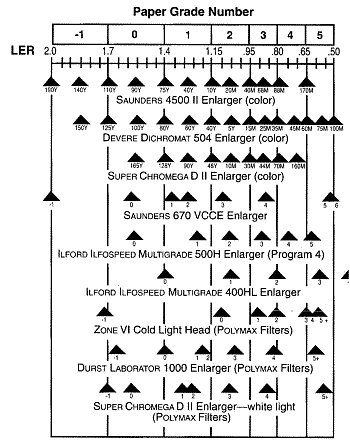 |
Examples: With a SUPER CHROMEGA D Enlarger (color head), you can
obtain paper grade 1 with 90Y dichroic filtration. To obtain paper grade
0, dial in 165Y filtration.
With the same enlarger, if you dial out all filtration to give white
light, using a POLYMAX 5+ Filter will yield paper grade 5.
PROCESSING
This paper is intended primarily for tray processing. Do not process
this paper in the KODAK ROYALPRINT Processor, Model 417; KODAK DEKTOMATIC
65 Processor; KODAK POLYMAX IR Processor, or similar roller-transport processors.
You can machine-process roll formats of this paper in continuous type
processors if the wash cycles are adequate for double-weight, fiber-base
papers.
Tray Processing
Tray develop with continuous agitation at 68F (20C), using the
appropriate dilution and development time recommended in the following
table.
KODAK
Chemical |
Dilution
(chemical+
water) |
Time
(min:sec) |
Capacity
(8 x 10-inch
Prints
per gal/L) |
| Developer-68 F (20C) |
DEKTOL (powder)
DEKTOL (liquid)*
POLYMAX T |
1+2
1+9
1+9 |
1:30
1:30
1:30 |
120/32
120/32
120/32 |
| Stop Bath 65 to 75 F (18 to 24C) |
Indicator
EKTAFLO |
1+64
1+31 |
0:15
0:15 |
80/20t
80/20t |
| Flxer/Replenisher (single bath)# 65
to 75F (18 to 24C) |
| Nonhardening fixer (for general printing
and for toning): |
Rapid Fixer,
Solution A (do not
use Solution B) |
1+7 |
5:00 |
100/26 |
Hardening fixers (for general printing
and continuous-type
processors):$ |
KODAK Fixer
POLYMAX T
Rapid Fixer
(Solution A and B)
KODAFIX Solution |
-
1+7
1+7
1+7 |
10:00
5:00
5:00
5:00 |
100/26
100/26
100/26
100/26 |
| Wash-- |
| With Washing Aid-65 to 75F (18 to
24C): |
Hypo Clearing
Agent |
stock
solution
1+4 |
3:00 |
80/20 without
pre-rinse;
200/50 with
1-minute
pre-rinse |
| Wash |
- |
20:00 |
- |
| Without Washing Aid-50 to 86F (10
to 30C): |
|
- |
60:00 |
- |
* Not available in all countries.
t Discard the solution when color changes to a purplish
blue.
# To increase capacity, use two fixing baths.
$ A hardening fixer may improve release on ferrotyping
drums.
Stop Bath
Bathe prints for at least 15 seconds at 65 to 75F (18 to 24C)
with continuous agitation in KODAK EKTAFLO Stop Bath, KODAK Indicator Stop
Bath, or 48 mL KODAK 28% Acetic Acid and water to make 1 L.
With EKTAFLO or Indicator Stop Bath, discard the solution when the
color changes to a purplish blue. Change Acetic Acid and water stop bath
after approximately twenty 8 x 10-inch prints per litre (eighty 8 x lOs
per gallon).
Fixing
Fix prints at 65 to 75F (18 to 24C) with frequent agitation. With KODAK
POLYMAX T Fixer, KODAK Rapid Fixer, or KODAFIX Solution, fix for 5 minutes
if you use a single bath. If you use two fixing baths, fix prints for 21/z
minutes in each bath, draining for 5 seconds between baths.
With KODAK Fixer, fix for 10 minutes if you use a single bath. If you
use two fixing baths, fix prints for 5 minutes in each bath, draining for
5 seconds between baths.
Note: Using a hardening fixer makes toning less efficient. For
the same amount of processing time, you'll see less of a toning effect.
Washing
Wash for 1 hour in running water at 50 to 86F (10 to 30C), interleaving
the prints carefully and frequently. The wash-water flow rate should provide
at least one complete change of water in the container every 5 minutes.
The KODAK Automatic Tray Siphon provides proper movement and agitation
during washing.
Avoid prolonged washing or soaking times to minimize physical damage
to the prints and to maintain the effect of the optical brightener in the
paper.
To reduce time and conserve water, use KODAK Hypo Clearing Agent before
washing. Transfer the prints, with or without a previous rinse, to the
clearing agent. Following the Hypo Clearing Agent, wash for 20 minutes
with agitation and normal water flow.
Drying
Remove as much surface water as possible from prints and dry prints
in a dust-free place. Place prints face down on cheesecloth, fiberglass,
or plastic screen racks; between photo blotters; or on a belt dryer.
For glossy prints made on F-surface paper, transfer the wet prints
directly from the wash to a ferrotype dryer (glazing machine) or to clean,
wet ferrotype plates. Squeegee the prints into close contact with the plates
and allow them to dry.
KODAK POLYMAX Fine-Art Paper, F Surface KODAK
POLYMAX Filters
Characteristic Curves
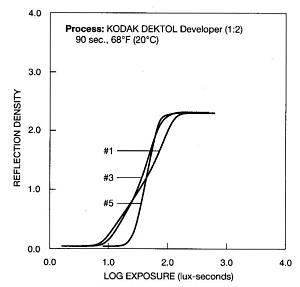 |
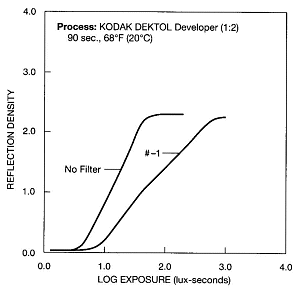 |
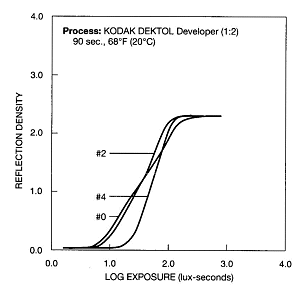 |
Spectral-Sensitivity Curves
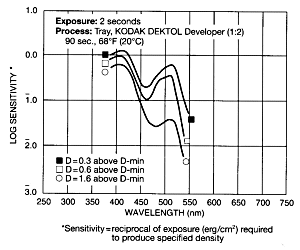 |
NOTICE: The sensitometric curves and data in this
publication represent product tested under the conditions of exposure and
processing specified. They are representative of production coatings and
therefore do not apply directly to a particular box or roll of photographic
material. They do not represent standards or specifications that must be
met by Eastman Kodak Company. The company reserves the right to change
and improve product characteristics at any time.
TONING
Treatment with a toner extends the life of prints that may be exposed
to oxidizing gases or subjected to adverse storage or display conditions.
KODAK Toners will protect prints whether or not they produce a tone shift.
| Processing |
Tone Shift with KODAK Toners |
| Full |
Moderate |
Slight |
Tray
(DEKTOL
Developer) |
Brown
(1:19) |
POLY-TONER
(1:24) |
POLY TONER
(1:4) |
POLY-TONER
(1:50 ) |
Rapid
Selenium
(1:3)
(1:9)
(1:20)
(1:40) |
| Sepia |
For more information on toning, see KODAK Publication G-23, Toning KODAK
Black-and-White Materials. It explains the technique of toning, and describes
Kodak toners and their effects on Kodak black-and-white papers and films.
MORE INFORMATION
Kodak has many publications to assist you with information
on Kodak products, equipment, and materials. The
following pamphlets are available from Kodak through the
order form in KODAK Publication No. L-1, KODAK Index
to Photographic Information. To obtain a copy of L-1,
send your request with $ 1 to Eastman Kodak Company,
Department 412-L, Rochester, New York 14650-0532.
G-7 KODAK POLYMAX Fiber Paper
G-23 Toning KODAK Black-and-White Materials
K-4 How Safe Is Your Safelight?
The following book is available from photo-specialty dealers who sell
Kodak products:
R-20 KODAK Black-and-White DATAGUIDE
Kodak, Dataguide, Dektol, Dektomatic, Ektaflo, Kodafix, Poly-Toner,
Polycontrast, Polymax, Royalprint, and T-Max are trademarks.
|




